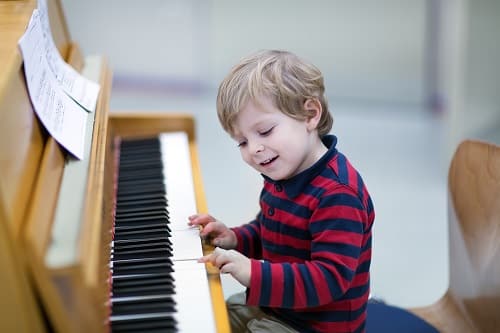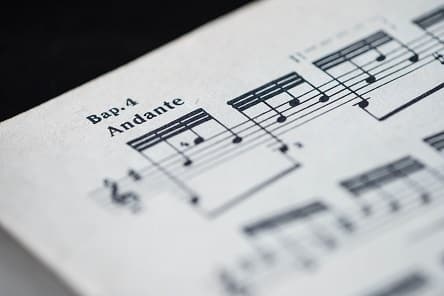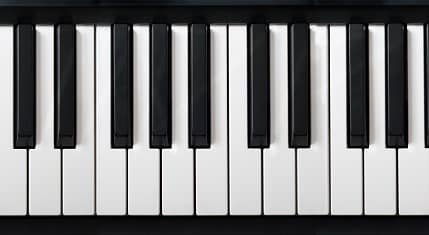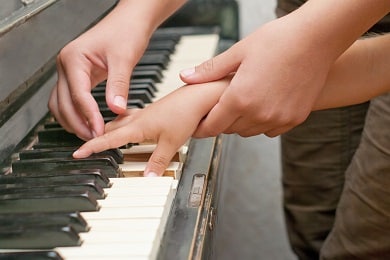As an Amazon Associate I earn from qualifying purchases.
Whether you’re an experienced piano teacher or parent, teaching piano to young students is a unique challenge; especially 5-year-olds! This is the most common age for beginner pianists. The way you approach teaching young piano students needs to be carefully thought out so that they will succeed later in their piano studies.
Here are 13 tips for how to teach piano to a 5 year old.
- Learn The Finger Numbers
- Practice Key Groupings
- Introduce The Musical Alphabet
- Daily Rhythm Activities
- Teaching Partial Staff
- Memorizing Intervals
- Implementing Sight Reading
- Using Flashcards
- Singing
- Teach Concepts, Not Repertoire
- Lesson Plan Accordingly
- Encourage Group Class Participation
- Be Patient
It’s important to remember that 5 years old is the age when kids are not entirely sure they want to learn a musical instrument, are starting homework, and of course, are learning how to be disciplined individuals! With that in mind, I’ve written this helpful guide full of tips for teaching young piano students so that they’re ready for more advanced studies later on. Let’s jump into the first step in the process!
Want to Learn Piano?Click Here

1. Learn The Finger Numbers

The first thing any young pianist needs to have a firm grip on is the finger numbers. For a teacher or parent struggling to teach a 5-year-old, it’s the best place to start. It’s the first thing I teach in my piano course because it’s just that important. Check out the Piano Jumpstart course to see my exact method for teaching this.
An easy way to teach this is to have the pianist place each of their hands on a piece of paper and trace them. After tracing their fingers, have the pianist label each of their fingers with a pencil from 1 to 5.
The next step that I find effective is to have them color each of their fingers a different color. You can set up a coloring legend featuring red, blue, green, purple, and orange. Each finger has its own color, and the goal is to match each of those colors to the hand that they traced.
The last step in the process, and perhaps most important is to see if the student can recognize the difference between the right hand and left hand. Since our finger numbers are opposites of each other, it’s important the student recognizes this so that they aren’t accidentally calling the pinky number 1 for example.
2. Practice Key Groupings

Before getting into the white keys, it’s important for young pianists to understand the black key groupings. At this age, kids are using pattern recognition in elementary school for math, and the same applies to the piano.
The keyboard is laid out with black and white keys, so it’s easier for them to see the groups of two and three black notes. Start them off by seeing if they can recognize all the groups of two black notes, and have them play each one they seem up and down the keyboard. Do the same with the group of three black notes.
From here you can start a simple playing exercise using finger 2 on both hands. Have them start from the center of the piano playing the left hand first, and then the right hand. As they play have them count “one, two, one, two” and then move up to the next group of two black notes.
This is a great way to build rhythm early and to train the ear to recognize low and high registers. Try to keep it simple with quarter notes and to move their hands for them so no pauses occur. They can do the same thing on the group of three black notes too, except using fingers 2, 3, and 4 this time.
3. Introduce The Musical Alphabet

Eventually, pianists will need to know the note names of each key. This is called the musical alphabet. It’s best to describe this alphabet as one that only has seven letters in it. So in this case, A,B,C,D,E,F,G.
Most piano method books have pianists start from middle C, but that can cause issues later on. It’s best for kids to be able to start from A as well. I have my students start counting up from the lowest A on the piano and go up the musical alphabet pattern saying the letters out loud as they press each key.
Once they become comfortable doing this after a few lessons, then I start quizzing them to find specific letters. Because they already understand the black key groupings, they’ll have a much easier time locating any note I ask them too.
Instead of just counting up from middle C, they can count from A, B, or any note that you ask them to. Keep in mind, they aren’t looking at any notes on the staff at this point, but simply locating notes visually by looking at the keys.
4. Daily Rhythm Activities
Each piano lesson that I teach involves rhythm activities. These activities mostly involve clapping or tapping a given rhythm. For beginners, I usually start with something that can be taught by rote.
I characterize it as a copycat game to keep my students interested. If they can copy me completely then they win a small prize like a sticker for their music book.
Introducing rhythms this way, the student can worry less about reading quarter notes and half notes and focus more on what they’re hearing and seeing me do.
As I clap I’ll count out loud too. An example of this would be doing a simple rhythm of “one, two, three-four”. I put stress on the last two beats so that the student is replicating a half note, even though they don’t quite know what it is yet. Or, if I just wanted quarter notes only I’ll just count it very straight with “one, two, three, four”.
Once the student is comfortable doing that rhythm I then start applying some notation to it and have them read the rhythm and clap. It’s best to introduce the concept to them through experience first before showing them what they’re actually clapping or tapping.
Other ways to encourage rhythm during the lesson involve students drawing up their own on a sheet of paper or on a whiteboard. Even playing games that involve walking around the room or jumping up and down to the desired rhythm is really beneficial.
For 5 year old’s especially, it’s important to incorporate rhythms early so that they are prepared for more difficult repertoire later in their studies. If you need some ideas for rhythm games to play, check out this video!
5. Teaching Partial Staff

There are a lot of piano method books that introduce musical concepts way too quickly; especially when it comes to teaching the musical staff. I recommend checking out my favorite piano method books for beginners so you know which ones to stick with for young students.
It’s a good idea to teach partial staff first because the grand staff is simply too overwhelming for most 5-year-olds. The grand staff has a lot to memorize and trying to distinguish spacing and memorize the locations of the notes on the staff is tough at first.
Using a partial staff involves building up from two lines and then progressing to three and four lines and spaces. While students can’t memorize the exact location of notes on the partial staff, they can utilize them for learning how to count intervals.
It’s much easier to pick out seconds and thirds on a partial staff rather than on the grand staff. Once students have a firm grip on the smaller intervals then you can expand the staff to 5 lines and start teaching fourths and fifths.
You could even make up your own short songs by giving the student a starting note and then notating something based on the partial staff. Have them measure the intervals between the notes in the melody as they learn it. The better they are at this, the better success they’ll have with the grand staff.
The Music Tree books do a really excellent job of introducing staff reading in this manner. I would encourage you to check out Time To Begin, and even grab the activities books to go with this level for a new student.
6. Memorizing Intervals
To improve note reading, students should work towards memorizing intervals with their eyes. It’s much easier to read something if you don’t have to count up and down the staff figuring out the distance between those pitches. A good way to start this process is to use musical flashcards like these.
I teach my students to do it quickly by using a timer. Each week the goal is for them to improve on the speed in which they can recognize each interval located on those flashcards. For young students, it’s a good idea to start with maybe 4 to 5 flashcards each week.
During each lesson assign the students 2 or 3 new cards to learn for the next week at home. This will make teaching them significantly easier in the future and make the lesson run much more smoothly.
7. Implementing Sight Reading
There is no good substitute for sight reading. Doing a little bit each lesson will help beginner students develop the ability to read new music much faster. There are a couple of specific ways to go about teaching sight reading to a beginner that I think will be helpful to you. Read my tips on how to sight read here.
8. Using Flashcards
Flashcards can be used as a warmup or even in the middle of the lesson as transition material. I even use them to play piano games with my beginners.
For beginner pianists, these cards can include anything from notes on the staff, finger numbers, and key signatures.
If there’s something more specific you need for the student to learn, you could simply make up your own flashcards. Put the symbol or term on one side of the card, and then add the answers on the back so students can cross-check their work on their own at home.
I find that my younger students respond best flashcards that are color-coded or are large in size. I use these flashcards from Alfred. They are great because each card is hole punched, which means students can keep them in their binder bringing them to and from lessons.
This set of cards also includes terms and symbols so that every area of music for a beginner pianist is covered.
9. Singing
A nice complement to sight reading is singing the music through. I find that singing really engages my students, and it helps develop their musical ear. The music you choose to sing should be something that’s well within a 5-year-olds pitch range.
Anything from middle C up to at least treble G should be well within reach. For students with higher pitch ranges, you might even consider going up to high G, but certainly no more than that far above the grand staff.
Many method books like Music Tree and Alfred already have words attached to the notes. The words sync perfectly, and the bigger words are even separated so that it all fits rhythmically. Singing helps greatly with counting too and should always be done whenever possible.
10. Teach Concepts Not Repertoire
I mentioned this earlier, but it’s never a good idea to teach a child piece after piece only. Instead, you should be teaching young pianists concepts. When teaching the concepts, students will be much better equipped to play anything they want to.
Students who don’t polish up their concepts tend to struggle when it comes to learning a new piece they’ve never seen before.
For example, there’s no sense introducing a student to eighth notes if they’ve never experienced those things before first. Much like when teaching rhythm, students this young should be trying those out from outside the scope of the repertoire itself.
So in this case, once they’ve polished up the ability to clap and count eighth notes properly, then you can show them what eighth notes are in notation form. Then from there, you can start introducing pieces that actually utilize eighth notes in action.
This way when a student sees them in their music they won’t be confused about how to interpret them or to count them. The same sort of approach can be used with dynamics, articulations, virtuoso techniques and more.
11. Lesson Plan Accordingly
Whether it’s a 5-year-old or an adult piano student, you should always have a plan of action in place. Lesson planning lessons really help when it comes to setting a student up for present and future success. My lesson plans look a little bit like the image below.

As you can see from the diagram above, I started this student off with a set of warmup exercises first. Included are the timed flashcards I mentioned above as well as some basic rhythms.
Next, I have a list of concepts I want to start teaching to my student, each of them carefully thought out based on repertoire we’ll be learning in the future. After this, we jump into music that we did the previous week.
From there we move on to the new pieces in my agenda. The thing to remember with lessons plans, especially when teaching beginner pianists is that chances are you won’t get through the entire thing.
Instead, you should use the lesson plan as a guide for what you want to do in the lesson, and then adjust the plan along the way. If there’s something you really wanted to get to but couldn’t, make note of it in the next week’s lesson plan.
Teaching a beginning pianist this way is really helpful because you can literally map out a plan for their success rather than teaching random things in each lesson.
12. Encourage Group Class Participation
Playing the piano can be a very lonely task. This is why group class participation is an absolute must for beginners. When they arrive at group class, they’ll be able to socialize with others who are doing the same kind of task they are. Group class isn’t just about playing games and hanging out though.
Real work can be done here, and the same sort of concepts and music learned in lessons can be applied here as well. If you’re a teacher, it’s a great opportunity to connect all of your students of similar ages and have them play in an ensemble together.
Young students can also take this opportunity to perform their pieces for other students too. Overall, group class promotes musical growth!
13. Be Patient
The most important thing you can do with any student is to be patient. Beginner pianists are going to make a lot of mistakes, and you as a teacher or parent have to be prepared to deal with plenty of that.
Being patient does not mean accepting less than satisfactory effort though. Students who are making mistakes due to lack of effort, practice or concentration should be pushed to be better. This is when lesson planning really plays an important role.
If the pianist is taking a long time to understand certain concepts then lesson planning gives you a chance to reevaluate the situation. You can easily build in exercises that cater more to that particular student because there is not a one size fits all solution to the problem.
As always, find ways to provide positive encouragement when students are making progress. A big part of piano playing is confidence, and the more of that you can instill in your students, the better of their progress will be.
Hello & thanks for stopping by! I’m a professional concert pianist and piano instructor. In the United States, I’ve given successful performances in several places including New York, Florida, Connecticut, & New Jersey, I have also performed internationally in Italy and made my Carnegie Hall debut in 2014. I enjoy blogging about the piano, the art of performance, general music, current events and the latest in music production.
